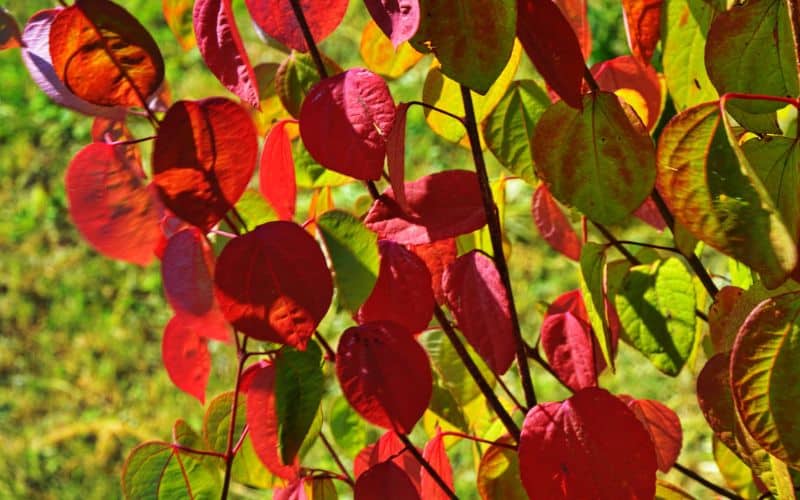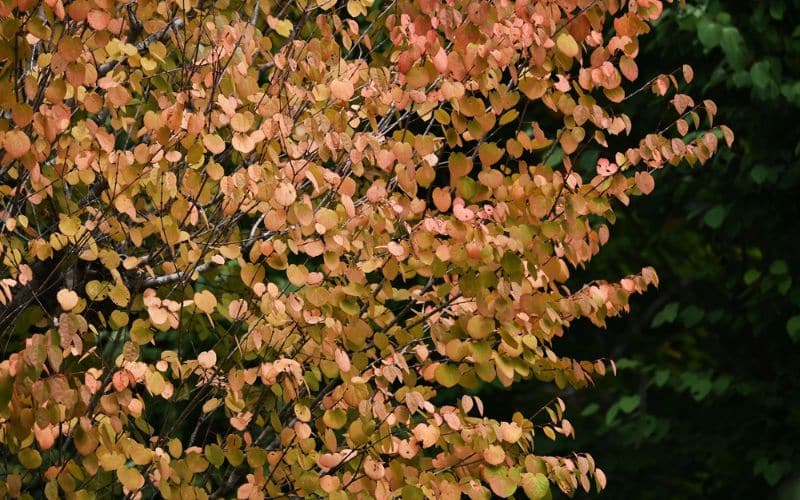
The Katsura tree (Cercidiphyllum japonicum) stands as a symbol of elegance and seasonal transformation in Ontario’s gardens and landscapes. With its golden yellow foliage in the fall, this remarkable tree offers more than just visual appeal; it brings a unique blend of beauty, versatility, and intrigue. From its heart-shaped leaves to its candy floss-like scent, the Katsura tree invites us to explore its characteristics, delve into planting considerations, and ponder thought-provoking questions that connect us to nature in a profound way.
Characteristics of the Katsura Tree
Leaf Shape: The Katsura tree has small, smooth-edged, heart-shaped leaves. The name “Cercidiphyllum” refers to the resemblance of its leaves to the redbud tree.
Size: The tree can grow up to 60′ tall and 40′ across at maturity.
Branching Habit: Katsuras tend to have a vase-shaped branching habit, which can be more pronounced and multi-stemmed.
Scent: Some reports suggest that Katsura’s autumn leaves give off a scent like candy floss, although not everyone may detect it.
Wildlife Attraction: The tree is well-behaved and attracts local wildlife.
Planting Considerations in Ontario
Space: The Katsura tree is significantly larger than some other options like serviceberry, so it requires ample space.
Availability: Katsuras are among the choices available through Toronto’s street tree program.
Messiness: Some might consider the Katsura tree messy due to its seed pods, leaves, and flowers, but others dispute this claim.

Maintenance and Care Guide
The Katsura tree, known for its moderate growth rate and ability to reach a height of up to 60 feet, requires specific care to maintain its beauty. The soil should be moist and well-drained, with a slightly acidic pH to support healthy growth. Regular watering is essential, especially during dry periods, to keep the tree hydrated and vibrant. Pruning is best done in late winter to early spring, allowing you to maintain the tree’s shape and remove any dead or damaged branches. Applying a balanced fertilizer in early spring can promote growth and enhance the tree’s overall health. Monitoring for common pests like aphids and caterpillars, as well as diseases such as leaf spot, is vital. If any issues arise, it’s advisable to consult with a local nursery for appropriate treatments, ensuring that the Katsura tree continues to thrive in your landscape.
Landscaping Design Ideas
The Katsura tree’s unique characteristics make it a versatile addition to various garden styles:
- Japanese Garden: Emphasize the tree’s Asian origin by incorporating it into a Japanese Zen garden with rocks, water features, and complementary plants like bamboo.
- Modern Landscape: Use the Katsura tree as a focal point in a minimalist design, pairing it with sleek hardscape elements and simple ground cover.
- Woodland Garden: Plant the Katsura tree among native shrubs and perennials to create a natural woodland setting.
- Street or Driveway Lining: Utilize the Katsura tree’s vase-shaped branching habit to line streets or driveways, creating a golden canopy in the fall.
- Mixed Border: Combine the Katsura tree with flowering shrubs, ornamental grasses, and perennials for a dynamic mixed border that offers year-round interest.
Community Insights
The planting of the Katsura tree in Ontario brings forth various community insights and considerations. If space is a concern, other smaller trees like Cercis (redbud) or serviceberry might be considered as alternative options. Timing is also crucial, as fall is an excellent time to plant the Katsura tree, but it should be done soon before the freeze to ensure successful growth. Local opinions vary, with some locals appreciating the Katsura for its beauty, while others question the introduction of foreign trees and advocate for native species. These insights reflect the diverse perspectives and needs within the community, highlighting the importance of thoughtful planning and consideration.
Conclusion
The Katsura tree’s golden fall foliage and unique characteristics make it a noteworthy addition to Ontario’s urban landscapes. Its planting, however, requires careful consideration of space, local ecology, and personal preferences. Whether you’re a homeowner looking to add a touch of gold to your garden or a city planner considering diverse tree options, the Katsura tree in Ontario offers a blend of beauty and complexity that can enrich our connection with nature.









